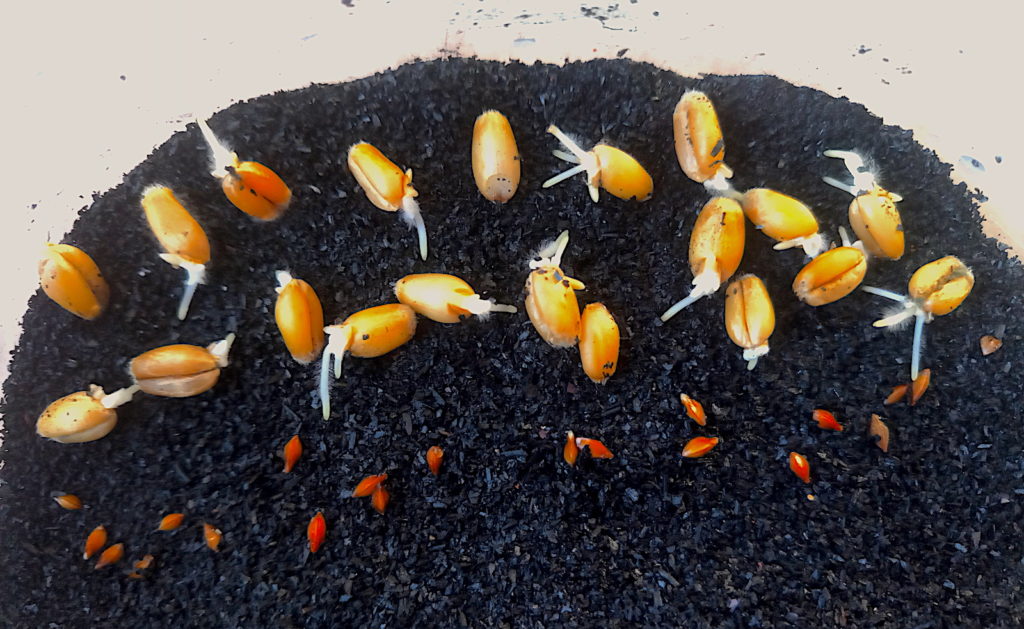Hello all, we are back with some good news of the monthly news of February 2021, this month we higlight:
- We work hard to deliver a good proposal for an international challenge.
- Experiments of seedballs with various materials.
- Improved Dronecoria frame with the revision 7.1.
Cisco Global Problem Solver Challenge
This is the video that we made for the Global Problem Solver Challenge of Cisco, we tried to answer the question: How can your early-stage innovative technology solutions solve the world’s most pressing environmental problems? Our answer is clear: Large Scale Reforestation.
Some reflexions from our seedlab
Masanobu Fukuoka’s nendodango seedballs, brought simplicity to the technique: Clay and seeds, together in a concrete mixer. The balls are dried and then spreaded in the places to be reforested, trying to imitate nature. Fukuoka increases the soil seed bank with protected seeds.
However, these seedballs are not intended to germinate quickly, but to protect the seed until they detect acceptable conditions to germinate. In the Mediterranean climate, due to the seeds own latencies, and the low and irregular rainfall regime, nengodango balls of forest species may take years to germinate and many may be predated, so there will be a low survival (2% in Japan’s climate, according to Fukuoka).
In agribusiness, the seed coating approach has been different. They have focused on creating very thin film coatings from a variety of materials. This small layer surrounding the seed can contain fungicides, fertilizers, beneficial fungi and bacteria, herbicides and hydrophilic materials, in specific proportions that increase crop yields.
Although there is a considerable amount of freely available scientific literature that discusses this seed coating technology, company secrets are stored safely. For example, many scientific papers merely test the materials provided by the companies, but do not include information on what the materials are.
In our open research, we are looking for a seedball that:
- Germinate as quickly as possible due to priming treatments.
- The coating materials do not slow down the germination speed.
- At the first rain, keep moisture in the seed for as long as possible.
- Include organic fertilizers to increase seedling vigor.
- Include organic repellents to reduce predation.
- Include microorganisms or spores.
To retain moisture increade the diameter of seedballs and use SAP, Super Absorbent Polymers capable of retaining more than 100 times their size in water. Each material affects seed germination in a particular way. Each material provides a pH, micronutrients, porosity… and seeds are very sensitive to these factors.
This means that the amount of field experiments to be done is enormous, we want to open the possibility for volunteers to come to our laboratory in Pitres in the Alpujarra to perform seed research.
We share with you some of our germination experiments
Biochar phytotoxicity
We put 25 seeds of Veza (Vicia sativa) half-buried between several types of materials, in this case biochar, sand and peat. To our surprise, we found that some biochars have a phytotoxic effect and inhibit germination:


Types of seeding in various materials
We wanted to understand how seeding type affected wheat and vinagrera (Rumex Scutatus) on various materials: red clay, kaolin, biochar and calcium carbonate.
We evaluated the following cases:
* S: Seed on Surface left to fall on the material.
* A: Tightly packed in the material remaining flush with the surface.
* AT: Tightly packed and slightly covered with material.
We observed that A germinated better than S, but that AT delayed emergence.

Even with light layers of material the germination was delayed, this is a problem that we will have to solve in the seedball we are looking for.
New revision 7.1 of our drone frame
After having made the accidental maiden flight of version 7, we publish this revision in our wikifactory repository that solves some errors in the engraving, improves the structural resistance, and adds the possibility of interchanging the landing gear, to adapt the final height of the drone to the different modular sowing mechanisms that we developped.
However, due to its configuration, it is still complicated to make it fly, so we still recommend to new users to cut the previous version 6 of the frame with 6mm plywood.
That’s all for this month, wait four our next montly news, will be exciting news, we promise.
Dronecoria Team






